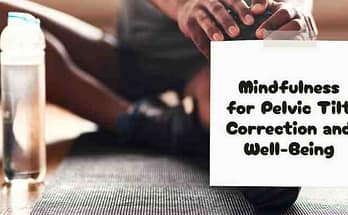As we spend more time sitting and less time moving, our posture can suffer. One common issue is anterior pelvic tilt, where the pelvis tilts forward, causing lower back pain and limiting mobility. While exercise and stretching can help correct this issue, massage therapy can also be a powerful tool to reduce anterior pelvic tilt and improve mobility. In this post, we’ll discuss how massage can help with anterior pelvic tilt and share some tips for incorporating massage into your routine.
| Key Takeaways |
|---|
| Massage can help reduce anterior pelvic tilt by releasing tension in the muscles that attach to the pelvis, improving mobility and reducing pain and discomfort. |
| Massage therapy can also be used to prevent further injury due to poor posture or muscle imbalances. |
| Regular massage sessions are recommended to ensure optimal results and long-term relief from anterior pelvic tilt related issues. |
| Incorporating stretches into your daily routine can help alleviate muscle tightness and improve overall mobility. |
| It’s important to work with a qualified massage therapist who has experience working with clients with anterior pelvic tilt and to combine massage with other treatments such as exercise and stretching. |
| Safety is critical when using massage to reduce anterior pelvic tilt and individuals should communicate openly with their massage therapist and be aware of potential risks. |
How Can Massage Help with Anterior Pelvic Tilt?
Anterior pelvic tilt can result in lower back pain, poor posture, and limited mobility. Massage therapy can be used to alleviate the symptoms of anterior pelvic tilt by focusing on the muscles that attach to the pelvis, such as the hip flexors, quads, and lower back muscles.
During a massage session, a qualified massage therapist will use various techniques to release tension in these muscles, such as myofascial release, trigger point therapy, and deep tissue massage. By releasing tension in these muscles, the pelvis can be realigned into its proper position, reducing the curvature of the lower back and improving mobility.
In addition to releasing tension, massage therapy can also increase blood flow to the affected muscles, promoting healing and reducing inflammation. This can make it easier to engage in exercise and other forms of movement that can help correct anterior pelvic tilt over time.
Regular massage sessions are recommended to ensure optimal results and long-term relief from anterior pelvic tilt related issues.
Combining massage therapy with other treatments, such as exercise and stretching, can also help improve mobility and alleviate the symptoms of anterior pelvic tilt.
However, it’s important to work with a qualified massage therapist who has experience working with clients with anterior pelvic tilt and to communicate openly about any concerns or conditions you may have. By taking these precautions, individuals can ensure that their experience with massage therapy will be safe and beneficial for reducing anterior pelvic tilt and improving mobility long term.
Benefits Of Massage Therapy For Anterior Pelvic Tilt
Massage therapy has numerous benefits for those suffering from anterior pelvic tilt. It can help reduce the amount of pain and discomfort associated with this condition, as well as improve mobility and posture. Massage can also be used to prevent further injury due to poor posture or muscle imbalances.
| Benefits | Description |
|---|---|
| Pain Reduction | Decrease in muscular tension that causes pain & discomfort |
| Increased Mobility | Improved ability to move freely without restriction |
| Posture Improvement | Increased awareness of proper body alignment & positioning |
| Injury Prevention | Reduced risk of future injuries caused by tight muscles & poor posture |
Regular massage therapy can alleviate symptoms associated with anterior pelvic tilt by promoting balance and flexibility throughout the musculoskeletal system. Massage therapy achieves this by releasing tension in the muscles that attach to the pelvis and by aiding in the maintenance of a healthy balance between opposing muscular groups.
Furthermore, stretching and deep tissue work, in combination with massage therapy, can help achieve optimal results and long-term relief from anterior pelvic tilt related issues. Therefore, it is recommended to incorporate regular massage sessions into a wellness routine to help maintain musculoskeletal balance and alleviate symptoms associated with anterior pelvic tilt.
Tips for Incorporating Massage into Your Routine
Here are some tips for incorporating massage into your routine to help reduce anterior pelvic tilt and improve mobility:
Find a Qualified Massage Therapist
To get the most benefit from massage therapy, it’s important to work with a qualified massage therapist who has experience working with clients with anterior pelvic tilt. Look for a therapist who has training in myofascial release, trigger point therapy, and other techniques that can help release tension in the affected muscles.
Focus on the Hip Flexors, Quads, and Lower Back Muscles
When receiving a massage for anterior pelvic tilt, it’s important to focus on the hip flexors, quads, and lower back muscles, as these are the muscles that attach to the pelvis and can contribute to the condition. Your massage therapist may use a variety of techniques, including myofascial release, trigger point therapy, and deep tissue massage, to release tension in these areas.
Incorporate Massage into Your Weekly Routine
To see the most benefit from massage therapy, it’s important to incorporate it into your weekly routine. This may mean scheduling a weekly massage appointment, or incorporating self-massage techniques at home. Self-massage techniques, such as foam rolling and using a massage ball, can be a great way to release tension in the affected muscles between massage appointments.
Combine Massage with Other Treatments
While massage can be a powerful tool for reducing anterior pelvic tilt, it’s important to combine it with other treatments, such as exercise and stretching, for best results. Your massage therapist can work with you to develop a comprehensive treatment plan that incorporates massage therapy, exercise, and other forms of movement to help reduce anterior pelvic tilt and improve mobility.
Don’t Forget to Stretch
Stretching is a key component in reducing anterior pelvic tilt and improving mobility. When your muscles are tight, they pull on your joints and can cause imbalances in your body. Incorporating stretches into your daily routine can help alleviate muscle tightness and improve your overall mobility.
Some great stretches to consider include:
Hip flexor stretch
This stretch targets the hip flexor muscles that are often tight in individuals with anterior pelvic tilt. Start by kneeling on one knee and placing the other foot in front of you, with your knee bent at a 90-degree angle. Slowly lean forward, keeping your back straight, until you feel a stretch in your hip flexors.
Glute stretch
The glutes play a key role in maintaining proper pelvic alignment. To stretch them, lie on your back with both knees bent. Cross one ankle over the opposite knee and gently pull your knee towards your chest until you feel a stretch in your glutes.
Hamstring stretch
Tight hamstrings can contribute to anterior pelvic tilt. To stretch them, sit on the ground with both legs straight out in front of you. Slowly reach forward towards your toes until you feel a stretch in your hamstrings.
Remember to hold each stretch for at least 30 seconds and to stretch both sides of your body evenly.
Safety Considerations When Using Massage To Reduce Anterior Pelvic Tilt
Safety is a critical component when using massage to reduce anterior pelvic tilt and improve mobility. It’s essential for individuals to understand the potential risks associated with this practice and take steps to minimize them. To help achieve this, we’ve compiled a table of safety considerations that should be taken into account before engaging in massage therapy:
| Massage Safety | Pelvic Tilt Safety | Anterior Tilt Safety |
|---|---|---|
| Communicate openly with your massage therapist about any concerns or conditions you have. | Make sure the area being massaged is properly supported by pillows or other props. | Be aware of the pressure applied during massage; too much pressure can cause pain and injury. |
| Wear comfortable clothing that does not restrict movement. | Ask your therapist if they are familiar with treating people who suffer from anterior pelvic tilt. | Discuss any allergies or sensitivities prior to having a massage session. |
| Drink plenty of water after receiving a massage as it helps flush toxins from your body. | Do not attempt self-massage without guidance from an experienced professional. | Stop immediately if you experience any discomfort during the procedure. |
By taking these precautions, individuals can ensure that their experience with massage therapy will be safe and beneficial for reducing anterior pelvic tilt and improving mobility long term.
Anterior pelvic tilt can cause a range of issues, from back pain to poor posture. Fortunately, incorporating massage therapy into your routine can help alleviate these symptoms and improve your overall mobility. Remember to consult with a licensed massage therapist and to make lifestyle changes, such as stretching and exercising, to maximize the benefits of massage therapy.
With consistent effort, you can correct your anterior pelvic tilt and live a happier, healthier life.
https://www.healthline.com/health/fitness-exercise/anterior-pelvic-tilt-exercises
FAQ
How often should I receive massage therapy to reduce anterior pelvic tilt?
It is recommended to receive massage therapy at least once a week initially, and then decrease frequency to once every two weeks or once a month as needed for maintenance.
Can massage therapy completely fix anterior pelvic tilt?
While massage therapy can greatly improve the symptoms associated with anterior pelvic tilt and aid in its prevention, it is important to combine massage therapy with other therapies such as exercise and proper posture to achieve optimal results.
Is massage therapy painful for people with anterior pelvic tilt?
Deep tissue massage can be uncomfortable, but should not be painful. It is important to communicate with your massage therapist to ensure they are using the right amount of pressure and that you are comfortable throughout the session.
Can massage therapy worsen my anterior pelvic tilt?
When performed by a skilled and experienced massage therapist, massage therapy should not worsen anterior pelvic tilt. It is important to communicate any discomfort or concerns with your massage therapist.
How long does it take to see results from massage therapy for anterior pelvic tilt?
The amount of time it takes to see results from massage therapy can vary depending on the severity of your anterior pelvic tilt and your body’s response to therapy. Some clients report feeling immediate relief after just one session, while others may require multiple sessions to see significant improvement. It is important to be consistent with massage therapy and to combine it with other therapies for optimal results.




